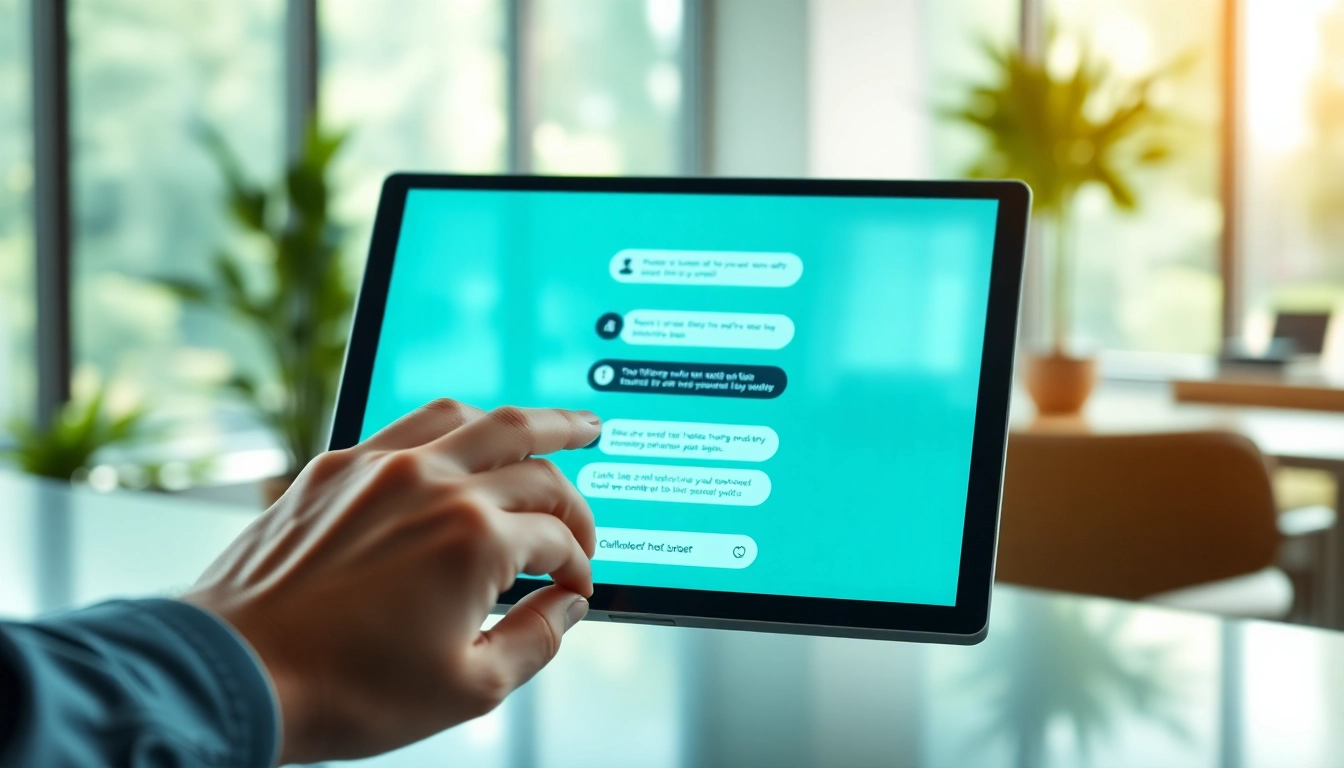Understanding ChatGPT Chatbots
What is a ChatGPT Chatbot?
ChatGPT chatbots are powerful AI-driven conversational agents developed using OpenAI’s advanced GPT (Generative Pre-trained Transformer) architecture. These chatbots are designed to understand, process, and respond to human language with remarkable fluency and coherence. Unlike traditional chatbots that rely on rigid, scripted responses, ChatGPT chatbots leverage deep learning to generate responses dynamically based on the context of the conversation. They can carry out extensive dialogues, answer questions, and engage users in a manner that feels natural and intuitive. For businesses looking to enhance customer interactions, implementing a chatgpt chatbot can be a game-changer, transforming mundane support functions into engaging conversational experiences.
Key Features of ChatGPT Chatbots
The effectiveness of ChatGPT chatbots stem from a variety of impressive features that make them an ideal choice for businesses. Below are some of the most noteworthy:
- Natural Language Understanding: ChatGPT chatbots excel in grasping the nuances of human language, allowing them to interpret questions accurately and provide relevant responses.
- Context Awareness: These chatbots can maintain context throughout conversations, enabling them to handle complex queries that require multiple turns in a dialogue.
- Personalization: ChatGPT chatbots can be trained on specific datasets, allowing them to tailor responses based on user preferences, enhancing the relevance of interactions.
- Multi-turn Conversations: Unlike basic bots, ChatGPT can engage in conversations that span several exchanges, providing a more engaging user experience.
- Scalability: Businesses can easily scale their chatbot solutions to handle an increasing number of queries without a proportional increase in cost.
How ChatGPT Chatbots Work
The underlying mechanism of ChatGPT chatbots relies heavily on artificial intelligence and machine learning. At a high level, the process involves training on vast amounts of text data, which enables the model to learn patterns, language structures, and conversational contexts. Here’s how it generally works:
- Training the Model: ChatGPT is initially pre-trained on large datasets containing text from books, articles, websites, and other written formats. This phase helps the model understand a broad range of language and knowledge.
- Fine-Tuning: After pre-training, the model undergoes fine-tuning on a narrower dataset, centered around specific dialogues and use-cases, to improve its ability to respond appropriately during conversations.
- User Interaction: When a user interacts with the chatbot, their input is tokenized, processed, and fed into the model, which generates a response based on its training and the conversation history.
- Iterative Learning: ChatGPT can continuously learn from user interactions and feedback, making it progressively better at delivering accurate and context-aware replies.
Benefits of Implementing a ChatGPT Chatbot
Improving Customer Support
One of the primary advantages of using ChatGPT chatbots is their ability to enhance customer support. By providing instant responses to frequently asked questions and offering 24/7 availability, businesses can significantly improve their customer service operations. Customers no longer need to wait for email replies or phone support; they can get immediate assistance through conversational agents. Moreover, ChatGPT chatbots can handle multiple inquiries simultaneously, ensuring that no customer feels neglected or unsatisfied.
Increasing Engagement and Retention
ChatGPT chatbots foster higher levels of user engagement through dynamic, personalized conversations. By understanding user preferences and interests, these chatbots can recommend products, suggest services, or even share content that aligns with user needs. This personal touch can significantly enhance customer satisfaction and loyalty, leading to improved retention rates. Research has shown that engaging customers in a conversational manner leads to a higher likelihood of repeat purchases and referrals, making ChatGPT chatbots a valuable investment for businesses aiming to build lasting relationships.
Cost Efficiency for Businesses
Implementing a ChatGPT chatbot can lead to substantial cost savings for businesses. Traditional customer service models often require a significant workforce to manage calls and inquiries, resulting in high operational costs. By automating these processes with a chatbot, companies can divert human resources to more complex tasks, ultimately optimizing labor costs. Additionally, ChatGPT chatbots can reduce training expenses, as they require less extensive training compared to new staff, while also being capable of providing consistent and accurate information across multiple interactions.
Common Challenges with ChatGPT Chatbots
Managing User Expectations
While ChatGPT chatbots have many strengths, managing user expectations remains a common challenge. Users may anticipate a level of understanding and responsiveness similar to that of a human. Businesses must communicate clearly that while chatbots are powerful tools, they are still limited by their programming and data. Establishing this understanding can prevent frustration and improve user satisfaction, especially when the chatbot fails to meet a user’s expectations.
Ensuring Accurate Responses
One inherent challenge of using AI-based chatbots is ensuring the accuracy and relevancy of responses. Given that these models generate replies based on learned data, there is a possibility of misinformation or irrelevant answers. To address this issue, businesses should implement robust training protocols that involve continuous monitoring and adjustment of the chatbot’s responses. Using user feedback to refine the system and adjusting training datasets can greatly improve response accuracy over time.
Integration with Existing Systems
Integrating ChatGPT chatbots with existing systems and software can pose significant technical challenges. These might include in-house customer service platforms, CRMs, or other databases that necessitate seamless communication. Careful planning and collaboration with technical teams can help ensure a consistent and functional chatbot experience. Utilizing APIs and middleware tools can facilitate better integration, allowing for smoother data flow and enhanced chatbot capabilities.
Best Practices for ChatGPT Chatbot Implementation
Designing User-Friendly Interfaces
A user-friendly interface is essential for engaging users effectively. When implementing a ChatGPT chatbot, consider designing an intuitive interface that is easy to navigate. Utilize simple language, clear prompts, and consider including visual elements such as buttons or quick replies that guide users in their interactions. A well-designed interface can reduce user frustration and encourage more meaningful engagement over time.
Training Your ChatGPT Chatbot Effectively
The effectiveness of a ChatGPT chatbot is heavily reliant on the training it undergoes. Implement a rigorous training regimen that includes diverse datasets reflecting various user interactions and scenarios. Regularly update the training materials based on feedback, usage analytics, and emerging topics within your industry. Conduct periodic assessments of the chatbot’s performance to identify gaps in knowledge or weaknesses in its conversational flow. By continually refining the training process, you can enhance the chatbot’s reliability and user satisfaction.
Monitoring Performance and Feedback
To ensure the ongoing effectiveness of your ChatGPT chatbot, implement a monitoring system to track its performance. Analyze metrics such as response times, customer satisfaction ratings, and the frequency of escalations to human agents. Pay attention to user feedback and sentiment analysis to gain insights into areas of improvement. By utilizing this data to adapt and refine your bot, you can continuously enhance the user experience and effectiveness of your chatbot strategy.
Future Trends in ChatGPT Chatbots
Advancements in AI Technology
The field of AI is rapidly evolving, with advancements that promise to enhance the capabilities of ChatGPT chatbots. Emerging technologies such as reinforcement learning, deep learning, and improved natural language processing algorithms are likely to result in even more sophisticated chatbots. These advancements will enable chatbots to provide even more accurate answers, understand complex queries with better context recognition, and interact with users in more natural ways. Keeping abreast of these developments will be critical for businesses wishing to fully capitalize on the potential of conversational AI.
Personalization Strategies
With increasing emphasis on personalization, future ChatGPT chatbots will likely incorporate deeper insights into user preferences and behaviors. This could involve integrating data analytics to tailor interactions based on previous conversations, user demographics, and real-time behaviors. Implementing such personalized strategies will create a more engaging user experience that resonates with individual customers, ultimately increasing loyalty and satisfaction.
Expanding Use Cases Across Industries
ChatGPT chatbots are poised to expand their footprint across various industries, moving beyond traditional customer support roles. Future applications may include personalized shopping assistants in retail, patient engagement tools in healthcare, and automated employee support systems in corporate settings. As more businesses recognize the benefits of AI-driven interactions, innovative use cases will continue to emerge, redefining how organizations interact with both customers and employees.







